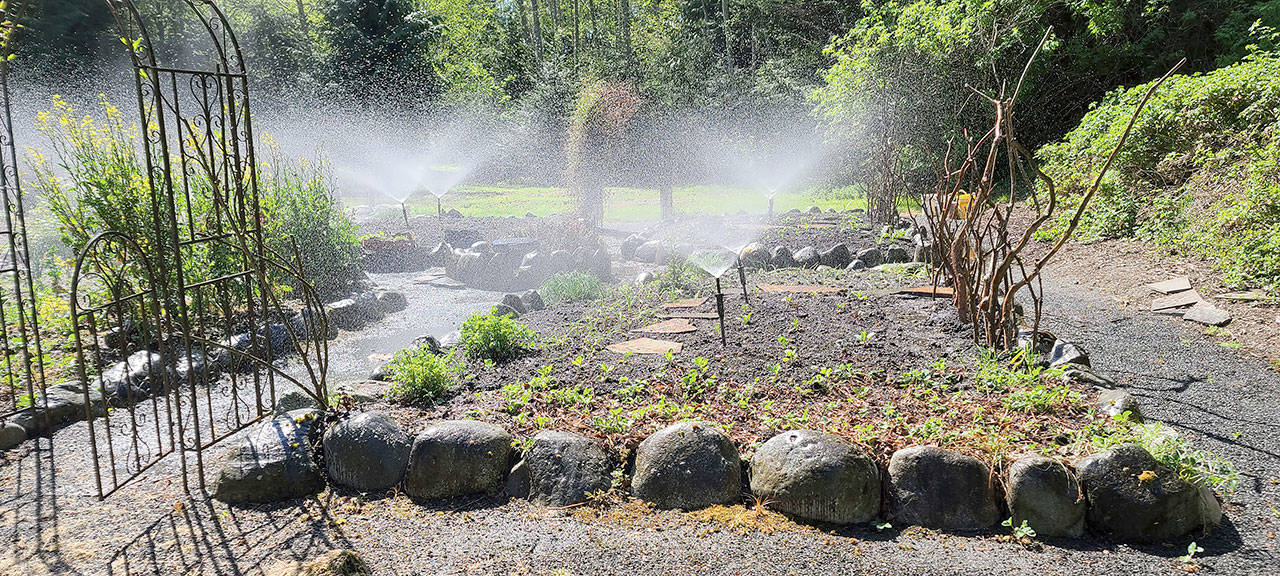WE’VE ALL HEARD the saying, “April showers bring May flowers.”
The problem is, this year’s April showers were little more than mist in the wind and March was a record-breaking hot spell.
To make matters worse, our warmer than normal April temperatures make for quicker and bigger May blooms, all of which need copious amounts of water at this stage of their rapid development.
So, as I looked out through the sprinklers last week, over the koi pond and out into the Strait of Juan de Fuca, I thought, water, water everywhere but not enough for the plants to drink.
Let’s look into the meaning of my badly manipulated cliché. First, our precipitation is down significantly, approximately 30 percent, this year.
Next, the sun has been out much more than usual, pushing the average temperature up significantly. This exacerbates the situation by drying out the ground more than expected for this time of year.
To make matters worse, all plants are requiring one of their highest demands for more water right now as they bloom, root and leaf out.
With these “perfect storm” conditions, many plants are in danger.
Foremost on the critical list are those plants just recently placed in the ground. Their root systems are not developed at all outside the little root ball they came with and thus are limited in the moisture they can absorb. Freshly planted garden items also have not fully interfaced with the natural soils around them. There definitely is a separation between the potted soil and the native soil.
Soil shrinks when it dries out. Just like your pots, baskets or containers, a gap develops so that when water does arrive, it runs quickly down this gap rather than sitting on the surface and soaking into the ground.
This dries out the soil even more after a watering, because the water flows down the sides and away.
Water often and heavily all your newly planted trees, bushes, flowers and shrubs.
Next on the danger list are all plants that have been stressed, diseased or otherwise suffered in years past. They have been weakened by whatever problem beset them last year and drought-like soil conditions can push them over the edge.
Soak them long and hard (1 inch of water) at least once a week. Keep them moist and adequately fed so they will survive. Mulching is a great idea.
Next on the trouble list are flowering trees and shrubs, especially edible fruit. In ornamental plants like rhododendrons, magnolias, wisteria, and even items like roses, flower longevity is in direct proportion to the available daily moisture.
When a plant goes dry, flowers are the first to suffer. Unlike the foliage, wilted flowers recover very poorly, if at all.
One of the saddest events could be a gorgeous wisteria coming into bloom this week and then be totally void of flowers next week because you were fooled into believing this week’s rain adequately watered this magnificent plant. Water your blooming plants every 3 to 5 days as they dry out.
Fruit trees, berries and nuts are another matter.
The ability to produce edible fruit is dependent on a fully developed flower, pollinated and setting its bud. A dry flower is a weak flower, resulting in little or no production. Such plants abort dry, small immature fruit.
Keep fruits and berry plants moist now and through out the year.
Remember that grass around these plants sucks up most moisture and fertilizer. Remove the grass and top dress a nice, deep (4 to 8 in.) cover of decomposed mulch.
Never cover the trunk, but rather leave a small dish or cone around the crown.
I have saved the worst problem for last — and it is you. Few people know how to water correctly.
In fact, because so many people think it is such a mindless task, it is the hardest thing for me to teach.
Turning the spigot on and off is the shortest and simplest task, yet many people believe that and getting the ground wet is all there is. Nothing could be further from the truth.
There is a technique.
When watering, start with the driest items and then water the edges of curbs, planters and flower beds, because these places dry out first and most rapidly. Then, water the whole area, including the edges, and the driest parts once again.
By again watering these dry areas along with the whole, everything is watered well two or three times.
If items are wilting, continue watering the whole yard in this manner, but finish by going over the dry plants one or more times.
Always water long enough to soak the ground down 8 to 12 in. You want the roots to grow down chasing the moisture and cool soil. The worst problem, especially in lawns, is watering too little (less than an inch) at a time.
Wetting the surface only causes the roots to move upward in a futile attempt to get moisture. The problem is the surface is the hottest, driest, windiest area and roots in that area are at great risk of suffering heat and dry stress this summer.
Let the water flow, let it flow often and let it flow deeply. And above all else … Please stay well all!
________
Andrew May is a freelance writer and ornamental horticulturist who dreams of having Clallam and Jefferson counties nationally recognized as “Flower Peninsula USA.” Send him questions c/o Peninsula Daily News, P.O. Box 1330, Port Angeles, WA 98362, or email news@peninsuladailynews.com (subject line: Andrew May).

